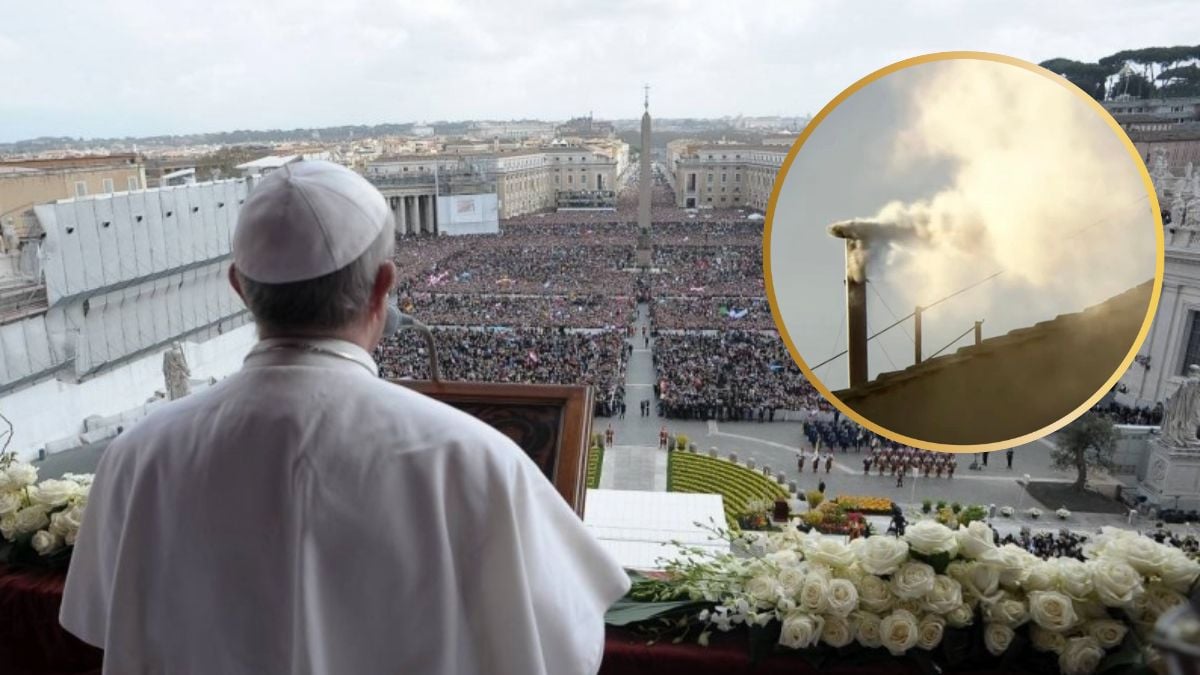
Habemus Papam! The Vatican has chosen the successor to Pope Francis, who passed away on April 21 at the age of 88. After four rounds of voting, the 133 cardinals convened for the Conclave reached a consensus and are now set to announce who will become the new pope of the Catholic Church.
Who will be the new pope?
The cardinals spent two days in seclusion inside the Sistine Chapel, with no contact with the outside world. Following three rounds of voting that produced black smoke, the fourth round brought clarity, and white smoke was finally seen rising from the chimney, signaling the election of a new pope. The sight of the white smoke sparked joy and celebration among the thousands gathered outside.
The ringing of the bells confirmed the cardinals’ decision, and the name of the chosen one is expected to be announced within minutes during the official proclamation ceremony, which will take place from the balcony of St. Peter’s Basilica.
ALSO READ Bob’s Discount Furniture will open more stores in the United States! Check where
Candidates to be the new pope
The names that have stood out most as potential successors to Pope Francis are Cardinals Pietro Parolin of Italy and Luis Antonio Gokim Tagle of the Philippines. Both have been regarded as leading contenders during the Conclave deliberations. However, there are several other figures who could also take on the role. Here are the candidates:
-
Pietro Parolin
-
Luis Antonio Gokim Tagle
-
Fridolin Ambongo
-
Anders Arborelius
-
Jean-Marc Aveline
-
Charles Maung Bo
-
Pablo Virgilio Siongco David
-
Peter Erdo
-
Fernando Filoni
-
Mario Grech
-
Claudio Gugerotti
-
José Tolentino Calaça de Mendonça
-
Seán O’Malley
-
Pierbattista Pizzaballa
-
Robert Francis Prevost
-
Joseph Tobin
-
Peter Turkson
-
Matteo Zuppi
What Does the Pope Do?
As the highest authority in the Catholic Church, the pope is regarded by the faithful as the representative of an unbroken line that traces back to Jesus Christ. He is considered the direct successor of Saint Peter, which grants him full authority over the Church and places him as a central figure for Catholics around the world.
What Happens When a Pope Dies?
When a pope dies or resigns, the cardinals are called to the Vatican to begin the process of selecting a new pope in the Sistine Chapel—a procedure known as the conclave. During the period between the vacancy and the election of the new pontiff, the College of Cardinals assumes governance of the Church.
Each cardinal casts an individual vote for who they believe should be the new pope. This voting process can take several days until a consensus is reached. The only clue visible to the outside world about the conclave’s progress is the smoke that emerges from a special chimney twice a day: black smoke signals no agreement, while white smoke announces that a new pope has been chosen.
ALSO READ Starbucks offers free cold foam! Here’s how to get it
How many popes has the Catholic Church had?
To date, the Vatican has had 266 popes. Pope Francis was the most recent, serving until his death in April 2025. These are the previous popes:
- Saint Pius X (1903–1914)
- Leo XIII (1878–1903)
- Pius IX (1846–1878)
- Gregory XVI (1831–1846)
- Pius VIII (1829–1830)
- Leo XII (1823–1829)
- Pius VII (1800–1823)
- Pius VI (1775–1799)
- Clement XIV (1769–1774)
- Clement XIII (1758–1769)
- Benedict XIV (1740–1758)
- Clement XII (1730–1740)
- Benedict XIII (1724–1730)
- Innocent XIII (1721–1724)
- Clement XI (1700–1721)
- Innocent XII (1691–1700)
- Alexander VIII (1689–1691)
- Blessed Innocent XI (1676–1689)
- Clement X (1670–1676)
- Clement IX (1667–1669)
- Alexander VII (1655–1667)
- Innocent X (1644–1655)
- Urban VIII (1623–1644)
- Gregory XV (1621–1623)
- Paul V (1605–1621)
- Leo XI (1605)
- Clement VIII (1592–1605)
- Innocent IX (1591)
- Gregory XIV (1590–1591)
- Urban VII (1590)
- Sixtus V (1585–1590)
- Gregory XIII (1572–1585)
- Saint Pius V (1566–1572)
- Pius IV (1560–1565)
- Paul IV (1555–1559)
- Marcellus II (1555)
- Julius III (1550–1555)
- Paul III (1534–1549)
- Clement VII (1523–1534)
- Adrian VI (1522–1523)
- Leo X (1513–1521)
- Julius II (1503–1513)
- Pius III (1503)
- Alexander VI (1492–1503)
- Innocent VIII (1484–1492)
- Sixtus IV (1471–1484)
- Paul II (1464–1471)
- Pius II (1458–1464
- Calixtus III (1455–1458)
- Nicholas V (1447–1455)
- Eugene IV (1431–1447)
- Martin V (1417–1431)
- Gregory XII (1406–1417)
- Innocent VII (1404–1406)
- Boniface IX (1389–1404)
- Urban VI (1378–1389)
- Gregory XI (France) (1371–1378)
- Blessed Urban V (1362–1370)
- Innocent VI (1352–1362)
- Clement VI (1342–1352)
- Benedict XII (1335–1342)
- John XXII (1316–1334)
- Clement V (1305–1314)
- Blessed Benedict XI (1303–1304
- Boniface VIII (1294–1303)
- Saint Celestine V (1294)
- Nicholas IV (1288–1292)
- Honorius IV (1285–1287)
- Martin IV (1281–1285)
- Nicholas III (1277–1280)
- John XXI (1276–1277)
- Adrian V (1276)
- Blessed Innocent V (1276)
- Blessed Gregory X (1272–1276)
- Clement IV (1265–1268)
- Urban IV (1261–1264)
- Alexander IV (1254–1261)
- Innocent IV (1243–1254)
- Celestine IV (1241)
- Gregory IX (1227–1241)
- Honorius III (1216–1227)
- Innocent III (1198–1216)
- Celestine III (1191–1198)
- Clement III (1187–1191)
- Gregory VIII (1187)
- Urban III (1185–1187)
- Lucius III (1181–1185)
- Alexander III (1159–1181)
- Adrian IV (1154–1159)
- Anastasius IV (1153–1154)
- Blessed Eugene III (1145–1153)
- Lucius II (1144–1145)
- Celestine II (1143–1144)
- Innocent II (1130–1143)
- Honorius II (1124–1130)
- Calixtus II (1119–1124)
- Gelasius II (1118–1119)
- Paschal II (1099–1118)
- Blessed Urban II (1088–1099)
- Blessed Victor III (1086–1087)
- Saint Gregory VII (1073–1085)
- Alexander II (1061–1073)
- Nicholas II (1059–1061)
- Stephen IX (X) (1057–1058)
- Victor II of Swabia (1055–1057)
- Saint Leo IX of Alsace (1049–1057)
- Damasus II of Bavaria (1048)
- Benedict IX (third term) (1047–1048)
- Clement II of Saxony (1046–1047)
- Gregory VI (1045–1046)
- Benedict IX (second term) (1045)
- Sylvester III (1045)
- Benedict IX (1032–1044)
- John XIX (1024–1032)
- Benedict VIII (1012–1024)
- Sergius IV (1009–1012)
- John XVIII (1004–1009)
- John XVII (1003)
- Sylvester II (999–1003)
- Gregory V (996–999)
- John XV (985–996)
- John XIV (983–984)
- Benedict VII (974–983)
- Benedict VI (973–974)
- John XIII (965–972)
- Benedict V (964–966)
- Leo VIII (963–965)
- John XII (955–964)
- Agapetus II (946–955)
- Marinus II (942–946)
- Stephen VIII (IX) (939–942)
- Leo VII (936–939)
- John XI (931–935)
- Stephen VII (VIII) (928–931)
- Leo VI (928)
- John X (914–928)
- Lando (913–914)
- Anastasius III (911–913)
- Sergius III (904–911)
- Leo V (903)
- Benedict IV (900–903)
- John IX (898–900)
- Theodore II (897)
- Romanus (897)
- Stephen VI (VII) (896–897)
- Boniface VI (896)
- Formosus (891–896)
- Stephen V (VI) (885–891)
- Saint Adrian III (884–885)
- Marinus I (882–884)
- John VIII (872–882)
- Adrian II (867–872)
- Saint Nicholas I (858–867)
- Benedict III (855–858)
- Saint Leo IV (847–855)
- Sergius II (844–847)
- Gregory IV (827–844)
- Valentinus (827)
- Eugene II (824–827)
- Saint Paschal I (817–824)
- Stephen IV (V) (816–817)
- Saint Leo III (795–816)
- Adrian I (772–795)
- Stephen III (IV) (768–772)
- Saint Paul I (757–767)
- Stephen II (III) (752–757)
- Saint Zachary (741–752)
- Saint Gregory III (731–741)
- Saint Gregory II (715–731)
- Constantine (708–715)
- Sisinnius (708)
- John VII (705–707)
- John VI (701–705)
- Saint Sergius I (687–701)
- Conon (686–687)
- John V (685–686)
- Saint Benedict II (684–685)
- Saint Leo II (682–683)
- Saint Agatho (678–681)
- Dono (676–678)
- Odatus II (672–676)
- Saint Vitalian (657–672)
- Saint Eugene I (654–657)
- Saint Martin I (649–655)
- Theodore I (642–649)
- John IV (640–642)
- Severinus (640)
- Honorius I (625–638)
- Boniface V (619–625)
- Saint Deusdedit or Adeodatus I (615–618)
- Saint Boniface IV (608–615)
- Boniface III (607)
- Sabinian (604–606)
- Saint Gregory I the Great (590–604)
- Pelagius II (579–590)
- Benedict I (575–579)
- John III (561–574)
- Pelagius I (556–561)
- Vigilius (537–555)
- Saint Silverius (536–537)
- Saint Agapetus I (535–536)
- John II (533–535)
- Boniface II (530–532)
- Saint Felix IV (III) (526–530)
- Saint John I (523–526)
- Saint Hormisdas (514–523)
- Saint Symmachus (498–514)
- Anastasius II (496–498)
- Saint Gelasius I (492–496)
- Saint Felix III (II) (483–492)
- Saint Simplicius (468–483)
- Saint Hilarius (461–468)
- Saint Leo I the Great (440–461)
- Saint Sixtus III (432–440)
- Saint Celestine I (422–432)
- Saint Boniface I (418–422)
- Saint Zosimus (417–418)
- Saint Innocent I (401–417)
- Saint Anastasius I (399–401)
- Saint Siricius (384–399)
- Saint Damasus I (366–384)
- Saint Liberius (352–366)
- Saint Julius I (337–352)
- Saint Mark (336)
- Saint Sylvester I (314–335)
- Saint Miltiades (Melchiades) (311–314)
- Saint Eusebius of Greece (309)
- Saint Marcellus I (308–309)
- Saint Marcellinus (296–304)
- Saint Caius (283–296)
- Saint Eutychian (275–283)
- Saint Felix I (269–274)
- Saint Dionysius (259–268)
- Saint Sixtus II (257–258)
- Saint Stephen I (254–257)
- Saint Lucius I (253–254)
- Saint Cornelius (251–253)
- Saint Fabian (236–250)
- Saint Anterus (235)
- Saint Pontian (230–235)
- Saint Urban I (222–230)
- Saint Callixtus I (217–222)
- Saint Zephyrinus (199–217)
- Saint Victor I (189–199)
- Saint Eleutherius (175–189)
- Saint Soter (166–175)
- Saint Anicetus (155–166)
- Saint Pius I of Aquileia (140–155)
- Saint Hyginus of Greece (136–140)
- Saint Telesphorus of Greece (125–136)
- Saint Sixtus I of Rome (115–125)
- Saint Alexander I of Rome (105–115)
- Saint Evaristus of Greece (97–105)
- Saint Clement I (88–97)
- Saint Anacletus (Cletus) of Rome (76–88)
- Saint Linus (67–76)
- Saint Peter (33–67)









